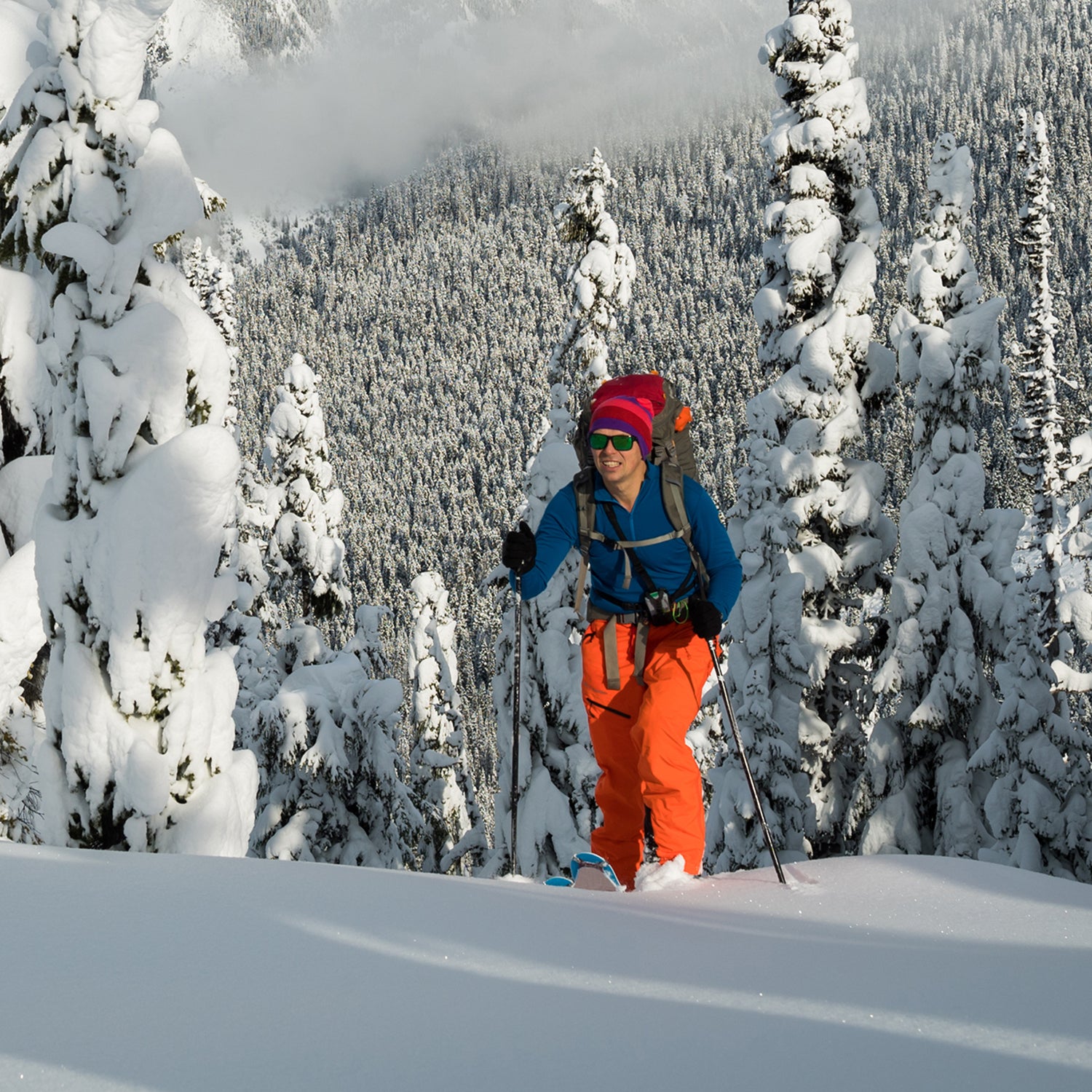Baselayers are the hidden workhorses of winter apparel. But out of sight doesn’t mean they should be out of mind—getting them right is important. A bad baselayer can ruin what would otherwise be a great adventure due to scratchy materials, a subpar fit, or an inability to dry out quickly. A perfect layer, meanwhile, can keep you warm, dry, and happy all day long. After copious testing, our team of testers has assembled a list of favorite men’s base layers for every winter condition and activity, from casual resort laps to frigid weeklong epics.
At a Glance
- Editor’s Choice: and
- Best for Winter Camping:
- Best Budget Merino: and
- Most Breathable:
- Best for Cold Hikes and Hunts:
- Most Versatile:
- Products to Avoid
- How to Choose Base Layers
- How We Test
- Meet Our Testers
If you buy through our links, we may earn an affiliate commission. This supports our mission to get more people active and outside. Learn more.
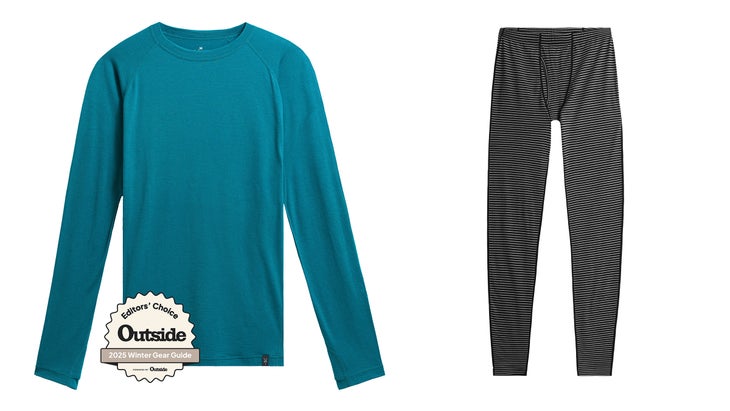
Editor’s Choice
Ibex Woolies Pro Tech Crew and Bottom
Sizes: S-XXL
Fit: Tight
Key Material: Merino wool/nylon Nuyarn blend
Breathability: 9/10
Warmth: 6/10
Wicking: 8/10
Pros and Cons
⊕ Forget-you’re-wearing-it comfort
⊕ Excellent wicking and moisture control
⊕ Odor resistant
⊗ Not super warm
The true sign of a great baselayer is that you’re still wearing it on the car ride home. That means it’s breathable rather than clammy, snug instead of constricting, and comfy enough that you forget you’re even wearing it. According to our testers, one base layer set checked those boxes every time they wore it: the Ibex Woolies Pro Tech Top and Bottom. From powder days in Tahoe to damp training runs, the Woolies became “the baselayer against which all others will henceforth be judged,” one tester declared.
In western Canada, the Woolies survived a gauntlet of winter smokejumper firefighter training sessions (including rainy runs, weighted hikes, and infrequent launderings) with little fuss—or stink. That’s thanks to the Nuyarn construction, which wraps odor-repelling merino wool around a nylon core, creating a lofty yarn that resists the stretching and tearing that can plague 100 percent merino garments.
In terms of design, one tester summed it up well, as “simple and highly functional.” Raglan sleeves on the crew top meant no seams to interfere with pack straps. Flatlock stitching throughout the top and bottoms boosted comfort, and generously sized thumbholes played well with gloves and mittens.
Despite all that we loved about the Woolies, they weren’t ideal in every condition. As Ibex’s lightest set of baselayers, they are by definition not the warmest. Testers found the Woolies sufficient to about 15 degrees, but too airy to sit still in during really cold conditions.
Best for Winter Camping
Seirus Reflective Heatwave Top and Bottom
��Coming Soon
Sizes: XS – XXL
Fit: Snug but not skin-tight
Key Materials: Polyester with reflective coating
Breathability: 4/10
Warmth: 9/10
Wicking: 6/10
Pros and Cons
⊕ Excellent comfort as a sleep layer
⊕ Affordable
⊕ Very warm
⊗ A bit restrictive for active use
Winter camping is all about overall warmth rather than the combination of warmth and breathability that we look for while skiing or snowshoeing. That’s why, even though they weren’t our favorites during active days, the Reflective Heatwave layers topped our list once the sun went down.
These layers from Seirus take a three-pronged approach to heat retention: a reassuringly thick polyester fabric, a shiny surface designed to reflect heat, and a soft fleece backing to trap that heat next to the skin. Combined, this equaled a top and bottom layer that were up to the coldest temperatures we experienced, which dropped into the negatives on one tester’s winter adventures in New Hampshire.
In frigid conditions like that, the Reflective Heatwave layers do serve as passable active layers as well. Still, other items we tested offered better stretch and comfort while in motion, and testers agreed that these very insulative layers are best reserved for campsite duty.
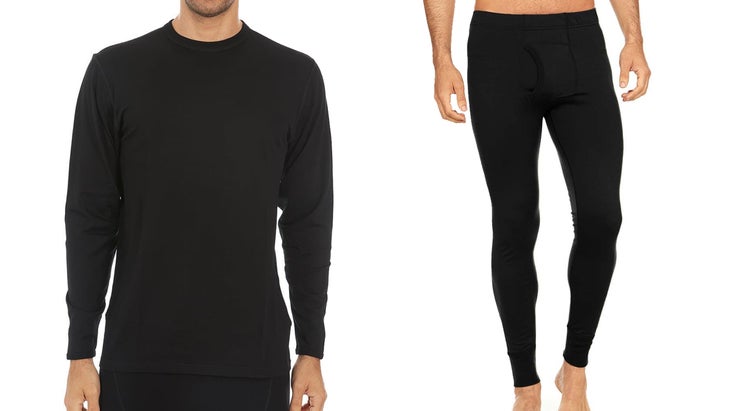
Best Budget Merino
Minus33 Ticonderoga Lightweight Crew and Saratoga Lightweight Bottom
Sizes: XS – XXXL, plus tall sizes
Fit: Snug, but not skin-tight
Key Material: 100 percent Merino
Breathability: 8/10
Warmth: 7/10
Wicking: 8/10
Pros and Cons
⊕ Great value for merino
⊕ No-nonsense design
⊗ No thumb holes in sleeves
⊗ Runs small
In 2025, 100 percent merino wool garments are a dying breed, often replaced by wool/nylon blends that boost durability. But the lightweight base layers from Minus33 are proof that all-natural layers still deserve a place in your gear closet. The reasons why start with price. These layers aren’t exactly cheap compared to run-of-the-mill synthetics, but at $75, they won’t break the bank, either.
Then there’s odor control. Any merino blend helps keep clothing from getting stinky, but pure merino does the best job. One tester said he couldn’t determine how often to wash his layers, because they never developed that telltale smell. Finally, they’re versatile. The crew top’s snug fit and lightweight material allows it to serve double duty as a standalone layer in spring and fall, although testers found it a bit too warm for summer hiking. One ding: The top has no thumbholes, a feature we look for to keep sleeves pulled down around our wrists.
PAID ADVERTISEMENT BY ARMS OF ANDES
Arms of Andes Alpaca Wool Base Layer: 300 Lightweight Half-Zip ($135)
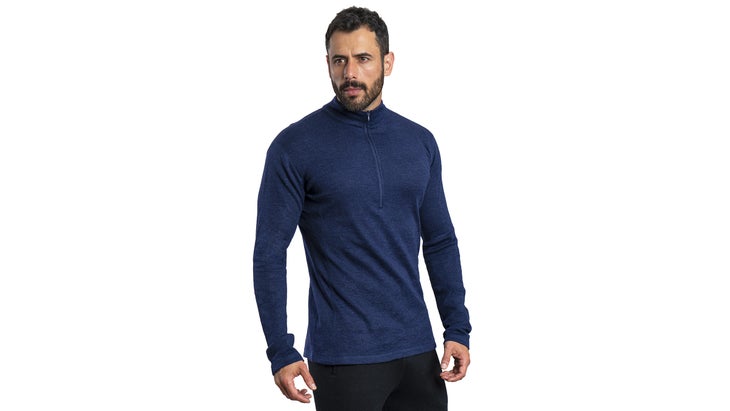
Everything you’ve heard is true: 100 percent Alpaca Wool outperforms Merino in all ways. And it’s essential your base layer, the foundation of your layering kit, is made from only the best material available. The lightweight, smooth, and highly-insulated fabric is perfect for any cold-weather adventure with moisture-wicking and oder resistant properties. The best part? Arms of Andes products, including the 300 Lightweight Half-Zip Base Layer, are made in Peru, right where the Alpaca Wool is sourced.
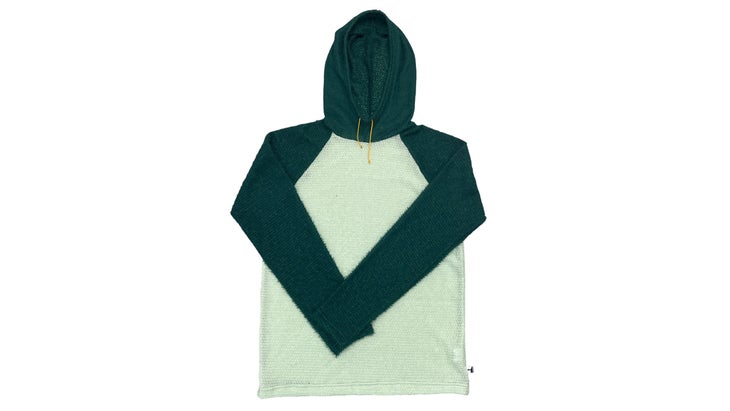
Most Breathable
FarPointe Alpha Cruiser Hoodie
Sizes: XS-XXL
Fit: Slim
Key Material: Polartec Alpha Direct
Breathability: 10/10
Warmth: 7/10
Wicking: 9/10
Pros and Cons
⊕ Next-level breathability
⊕ Works as base layer or ultralight midlayer
⊗ Prone to snagging and pulling
⊗ No wind resistance
The Cruiser Hoodie’s breathability magic comes down to materials, namely, Polartec Alpha Direct, a wispy-thin fleece that offers an unexpected blend of warmth and air flow. In calm conditions, our testers marveled at how warm this fuzzy, nearly see-through fabric was. But it’s also very fragile, and more than one of our testers reported snagging and tearing the Cruiser (one on a brushy trail, the other thanks to a pet cat).
That fragility led to mixed reviews. Our Alaskan tester, whose winter trips inevitably involve bushwhacking, found it far too delicate. But on the well-manicured trails in the high desert of southern Idaho, I found a use for the multifunctional Cruiser on nearly every hiking and Nordic skiing trip I took: it served as a super-plush sleep layer year-’round, a cozy base layer in cold-weather, and a highly breathable midlayer in shoulder seasons, especially when paired with a thin windshirt. Best of all, it’s incredibly light: At 4.4 ounces, it weighs less than most sun hoodies.
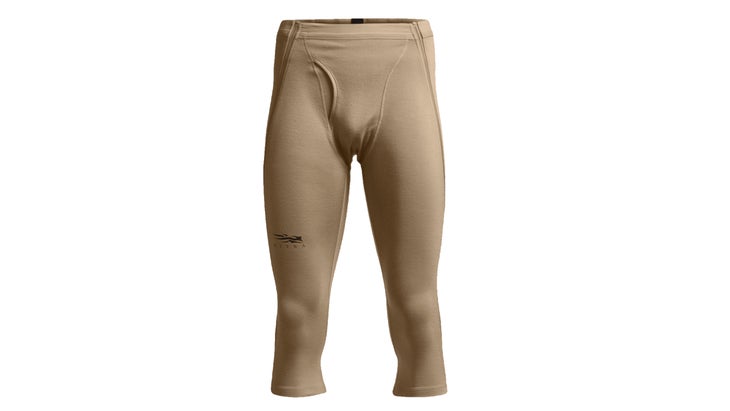
Best for Cold Hikes and Hunts
Sitka Core Merino 330 Zip-Off Bottom
Sizes: M-XXL
Fit: Loose
Key Materials: Merino wool/nylon blend
Breathability: 5/10
Warmth: 10/10
Wicking: 6/10
Pros and Cons
⊕ Easy on and off
⊕ Mid-calf length works well with boots
⊗ Pricey
⊗ Baggy on skinny frames
Zip-off long johns belong to an exclusive category of gear that we didn’t know we needed but can’t go without now that we’ve seen the light. The appeal is simple: you can remove your leggings without taking off your pants or boots. Does that sound like a small upgrade? Don’t tell our testers that. “On multi-day winter trips when it feels like your whole day is spent managing layers, these really are a game-changer,” one reported after a late fall hunting trip in Utah.
Rather than opting for a lightweight legging that’s too cold in camp and too warm while moving, the 330 bottoms (named for the 330 grams per square meter merino-and-nylon blend that Sitka uses) do away with trying for versatility. Instead, they’re properly warm and thick, and easy to strip off when you inevitably overheat. One ding: This set sports a looser fit, so those with slimmer builds might find them too baggy, especially at the leg opening.
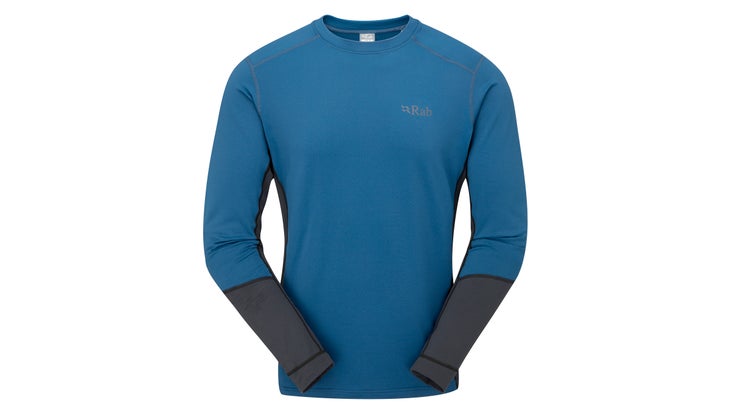
Most Versatile
Rab Conduit Crew
Sizes: S-XXL
Fit: Tight
Key Material: Recycled polyester
Breathability: 8/10
Warmth: 7/10
Wicking: 8/10
Pros and Cons
⊕ Performs well in a range of temps and conditions
⊕ Great wicking capabilities
⊕ Soft and cozy
⊗ A little on the heavy side
Despite the widely different range of tester expectations, sports, and geography, the Conduit was a unanimous favorite thanks to its extreme comfort and versatility across a wide range of temperatures. After months spent skiing at Sugarbush and mountain biking around Burlington, Vt., one tester’s notes on the Conduit were simple: “Rab just seems to have the best materials.”
All agreed that there must be some form of alchemy in the 92-percent recycled polyester, eight-percent elastane weave that manifested in a lightly gridded fleece backer. Testers praised the comfort in a variety of conditions and uses: One wore it beneath a couple layers in temps around the tens during heavy sideways snow in central Oregon; another wore it alone during a 40-degree overcast run in the Ashland watershed. At 6.9 ounces, it was on the heavy side for the top end of our temperature range, but the micro-channeled gridded fleece moved excess heat with aplomb. “It was great at wicking moisture,” remarked a tester after taking it on a long run in 45-degree temps while wearing a pack. All agreed this top will serve as a reliable, go-to layer, all winter long.
Products to Avoid
It might be tempting to equate base layers with any long underwear, but steer clear of the inexpensive “waffle” thermals from brands like Hanes or Fruit of the Loom: these are generally cotton, which dries slowly and doesn’t retain heat when wet. In winter conditions, wet cotton is downright dangerous and can lead to hypothermia.
How to Choose Base Layers
Comfort is paramount when purchasing base layers. Every body and every skin type is different so dialing in the materials that feel the best on your skin is the most important part of the base layer buying journey. In general, quality baselayers will be constructed of either polyester or merino wool, with spandex, elastane, or nylon spun into the fabric to increase stretch or durability. Polyester layers are usually cheaper and quicker to dry, while merino is more expensive, dries slower (but retains heat while wet), and is more odor-resistant. Which is better comes down to personal preference: some love the soft hand of natural fibers, but even the most advanced, small-micron merino wool material can make someone with a wool intolerance miserable.
Once you have landed on a material that works for your skin, start looking into moisture movement. If you sweat a ton, as many of the testers for this category do, look into lightweight synthetic base layers, as they have an excellent track record for moving moisture efficiently. If you do not sweat much, then you can get away with thicker next-to-skin layers that will also be warmer when you’re not in motion.
In terms of design, base layers are pretty straightforward. To maximize comfort, look for upgrades like flatlock seams and raglan sleeves, which can prevent chafing, especially when wearing a pack.
How We Test
- Number of Products: 34
- Number of Testers: 11
- States Tested In: 10
- Temperature Range: -5 to 60 F
While the communication process varied from detailed descriptions on Google documents to handwritten notes over giggles and beers, the testing process itself was uniformly all business. Our team racked up hundreds of miles run, ridden, and skied in conditions ranging from sub-zero mid-mountain whiteouts to mild seaside runs.
Meet Our Testers
Category manager Nathan Pipenberg has been testing men’s apparel for ���ϳԹ��� for three years and also serves as ��������貹������’s ultralight columnist. This year, he put gear to the test on winter hikes, resort laps, and late-season trail work missions.
Ultra Running Coach, Trails and Tarmac owner, running shoe reviewer, and podcaster Brett Hornig put down well over 100 running miles testing layers in wintry conditions.
Greg Durso, Program Director for The Kelly Brush Foundation, is one of the hardest charging, most prolific, adaptive ski and mountain bike athletes on the East Coast.


